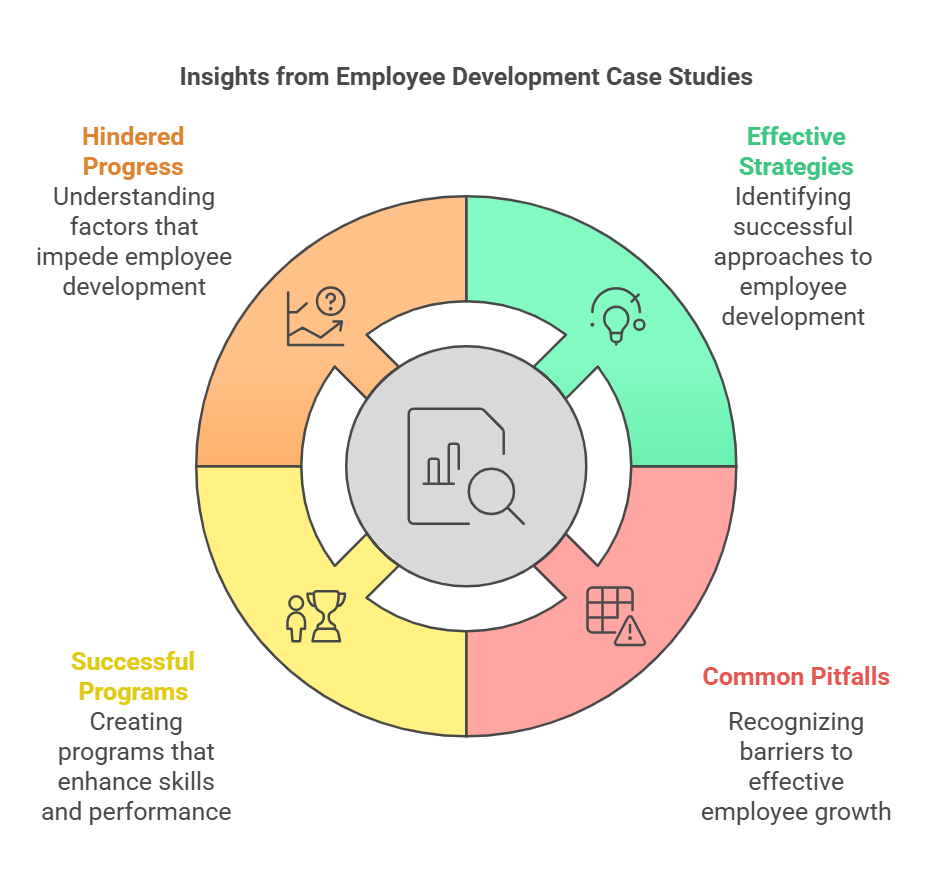Want to unlock your team’s full potential and drive business success? Look no further. Our collection of employee development case studies showcases top organizations that have achieved impressive results through targeted development programs.
Learn how to replicate their success and transform your workforce into a high-performing, engaged, and motivated team.
Employee development is a cornerstone of organizational success. However, not all strategies yield the desired results. Learning from real-world case studies can provide valuable insights into what works and what doesn’t.
In this blog, we will explore key examples, identify common challenges, and offer actionable solutions.
Why Employee Development Matters
In a competitive landscape, organizations need skilled and motivated employees to thrive. Effective employee development programs:
- Improve job satisfaction and retention.
- Build critical skills for future growth.
- Boost productivity and performance.
But how can companies ensure their development initiatives are impactful? Let’s look at some case studies to understand the dynamics.
Case Study 1: Effective Training Leads to Higher Retention
The Scenario
A mid-sized IT company faced high employee turnover, particularly among junior developers. Exit interviews revealed a lack of growth opportunities as the primary reason.
The Solution
The company introduced:
- A structured mentorship program pairing juniors with senior developers.
- Quarterly skill-building workshops on emerging technologies.
- A clear career progression framework.
Results
Within a year, the turnover rate dropped by 25%, and employee engagement scores increased significantly. Junior developers reported feeling more valued and confident in their roles.
Key Takeaway
Providing clear growth paths and continuous learning opportunities can boost morale and reduce attrition.
Case Study 2: Lack of Personalization Hurts Engagement
The Scenario
A large retail chain rolled out a generic training program for all employees. While the intent was good, the one-size-fits-all approach led to poor participation and low engagement.
The Challenge
Employees in different roles and locations had varying needs, but the program failed to address them.
The Solution
After analyzing feedback, the company restructured its training by:
- Segmenting employees based on their roles and skill gaps.
- Offering role-specific learning modules.
- Including self-paced online courses for flexibility.
Results
Participation rates increased by 40%, and managers noticed a visible improvement in on-the-job performance.

Key Takeaway
Tailoring development programs to individual needs enhances participation and effectiveness.
Common Pitfalls in Employee Development
1. Lack of Clear Goals
Without clear objectives, development programs can lack direction and purpose.
Solution: Define measurable goals and align them with organizational priorities.
2. Neglecting Feedback
Ignoring employee feedback leads to programs that don’t address real needs.
Solution: Regularly collect and act on feedback to make improvements.
3. Overloading Employees
Too many training sessions in a short span can lead to fatigue.
Solution: Space out sessions and incorporate practical applications.
Also Read
How to Build an Employee Development Calendar for 2025
5 Learning Styles and How to Cater to Them in Employee Development
Case Study 3: Collaborative Learning Sparks Innovation
The Scenario
A manufacturing firm wanted to encourage innovation among its staff. Traditional top-down training methods weren’t producing desired results.
The Solution
The company introduced collaborative learning initiatives, including:
- Cross-departmental brainstorming sessions.
- Peer-to-peer knowledge sharing.
- Innovation challenges with rewards for the best ideas.
Results
Employee satisfaction improved, and several innovative ideas were successfully implemented, boosting efficiency and reducing costs.
Key Takeaway
Encouraging collaboration and peer learning can unleash creativity and innovation.
What Doesn’t Work: Lessons from Failures
Overlooking Soft Skills
Focusing solely on technical skills while ignoring soft skills like communication and leadership can limit overall development.
Lesson: Include soft skills training in your programs to nurture well-rounded employees.
Ignoring Cultural Fit
Training methods that don’t align with the company’s culture often fail to resonate.
Lesson: Design programs that reflect your organization’s values and ethos.
Actionable Tips for Successful Employee Development
- Assess Needs: Conduct regular assessments to identify skill gaps.
- Set Clear Goals: Align training objectives with business priorities.
- Encourage Feedback: Use employee input to refine programs.
- Measure Impact: Track progress through performance metrics.
- Promote Flexibility: Offer a mix of in-person and online learning options.
Final Thoughts
Employee development is an ongoing journey. By learning from successful case studies and avoiding common pitfalls, organizations can create impactful programs that drive growth and satisfaction. Remember, the key lies in understanding employee needs, setting clear goals, and continuously refining your approach. With the right strategies, your team can achieve its full potential and your organization can reap the benefits of a skilled, engaged workforce.
